Key takeaways:
- Purple light is a combination of the blue and red light wavelengths that plants need to grow. White lights, on the other hand, are a combination of red, green, and blue light that includes the full visible spectrum.
- UV and blue light are best for seed germination.
- Vegetative growth is supported by the whole color spectrum.
- Red wavelengths are more easily absorbed by plants, and this increased energy supply is used to create reproductive materials (flower buds and seeds).
When you take a look at other people’s cannabis grow setups, often you’ll find some that have purple LED lights, or red and blue LEDs. Purple grow lamps actually used to be more common, until the development of full spectrum white lights. The difference is important: blue and red light are essential and sufficient for plant growth, but full spectrum light includes more color wavelengths, particularly green, that contribute to more optimal lighting conditions and more productive growth.
purple grow light vs. white light: what’s the difference?

Purple light is a combination of the blue and red light wavelengths that plants need to grow. White lights, on the other hand, are a combination of red, green, and blue light that includes the full visible spectrum. Full-spectrum, white lights are able to give plants all types of light wavelengths, each of which performs a particular role in the plant’s development. While purple lights give the essential wavelengths for cannabis plant growth, the inclusion of green, and sometimes UV and far-red light, add other layers of developmental support that can produce higher quality and higher yielding marijuana plants. Whether you use white or purple LED grow lights, or both, we’ll help you understand how to use each light color for the best possible plant growth.
A full spectrum LED light like this one covers all of the bases:
purple grow lights
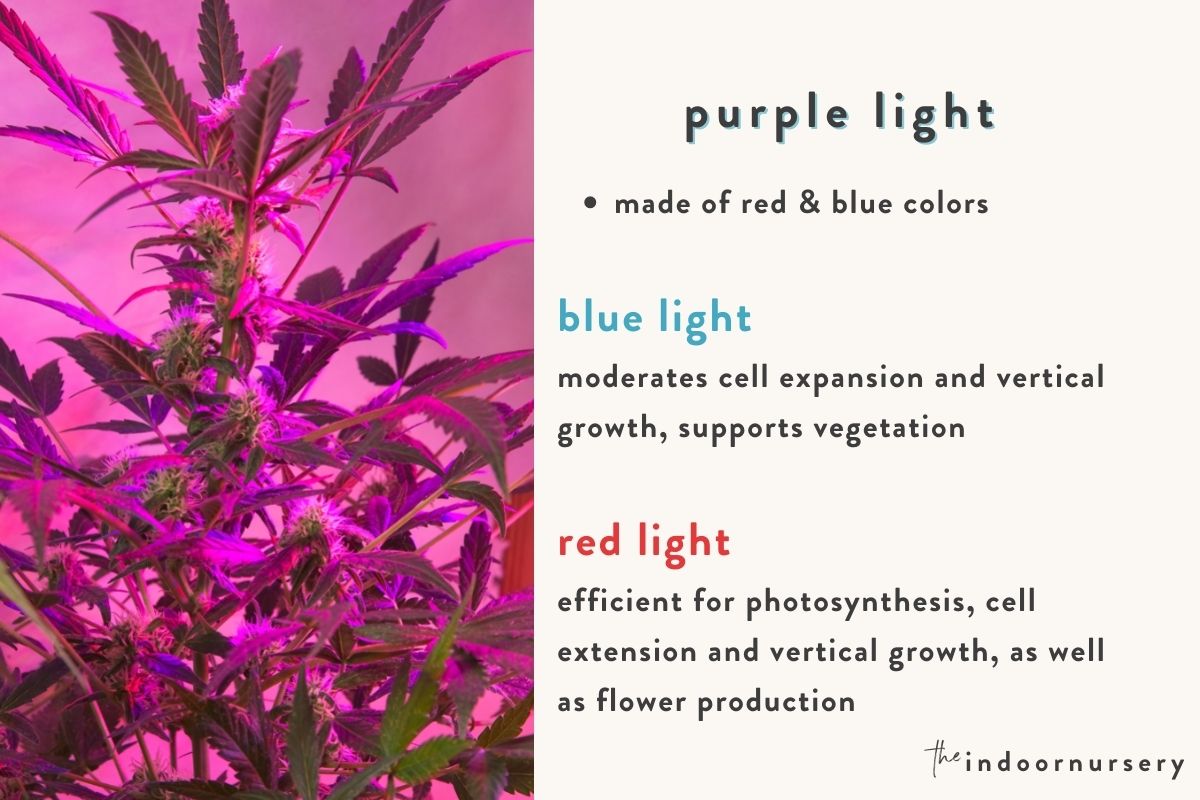
Purple grow lights are made of two colors: red and blue. These colors were isolated because they were thought to be the most important to plant growth. Blue light is important for leaf development and stems, while red light most supports reproductive growth, including fruiting and flowering. Green light is reflected from plants, which is why we see them as green. While it was once thought that lights don’t need the green wavelengths, we have learned that green light still contributes to photosynthesis in plants.
disadvantages of purple light
Purple lamps that only provide red and blue light can be enough for plants to grow, but the isolated wavelengths only provide some of the wider range of energy that the sun and full-spectrum bulbs emit. Removing what was considered nonessential frequencies has turned out to not be a benefit to plant health, and although these types of bulbs may be slightly more energy efficient than full-spectrum lamps since the need to power those other colors isn’t there, the energy savings is minimal.
Another significant disadvantage to using purple lamps to grow plants is the color itself. Purple light makes it difficult to inspect and assess the plants due to the unusual coloration. Without green light wavelengths to be reflected, the plants don’t show as green, but as dark purple, even close to black. This makes it challenging to notice if your plant’s color is off, if there are pests, or if mildew or a disease has taken hold.
white grow lights
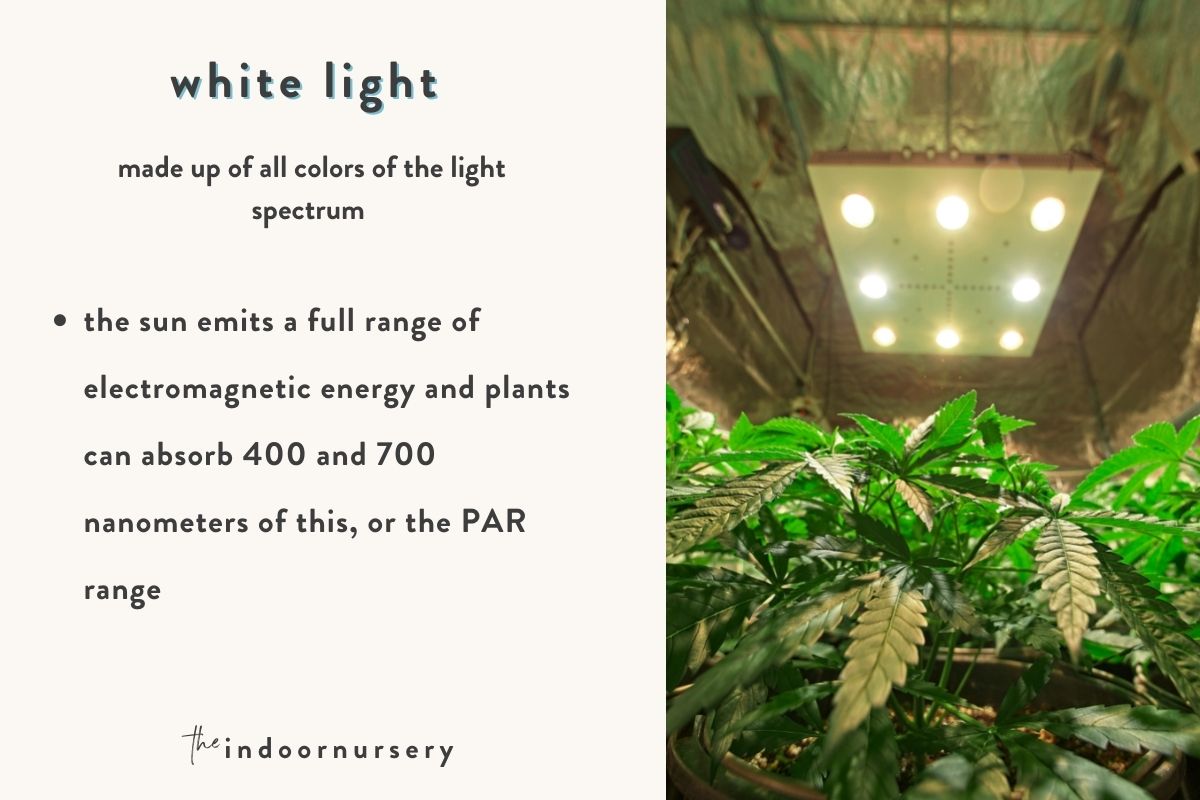
White grow lights include all colors of the light spectrum, including red, blue, and green. The addition of green light fills in the wavelength gap between blue and red, and they mix to show all colors in the visible range. While plants will use whatever light is available to grow, having the full range of wavelengths maximizes quality and growth of the plant. Cannabis plants will survive in purple light, but thrive in white.
The importance of all colors has to do with the fact that the sun, which conditioned cannabis plants in nature, emits a full range of electromagnetic energy. Plants can absorb a certain range of this, between about 400 and 700 nanometers, known as the PAR range, or photosynthetically active radiation. This range is sometimes extended to between 200 to 900 nanometers to account for UV light on one end, and infrared light on the other.
The different color wavelengths and everything in between contribute to different aspects of a plant’s growth process:
- Blue light – moderates cell expansion and vertical growth, supports vegetation
- Green – gives plants their color, some light penetrates deep into plant tissue
- Red – red light is efficient for photosynthesis, cell extension and vertical growth, as well as flower production
blue light
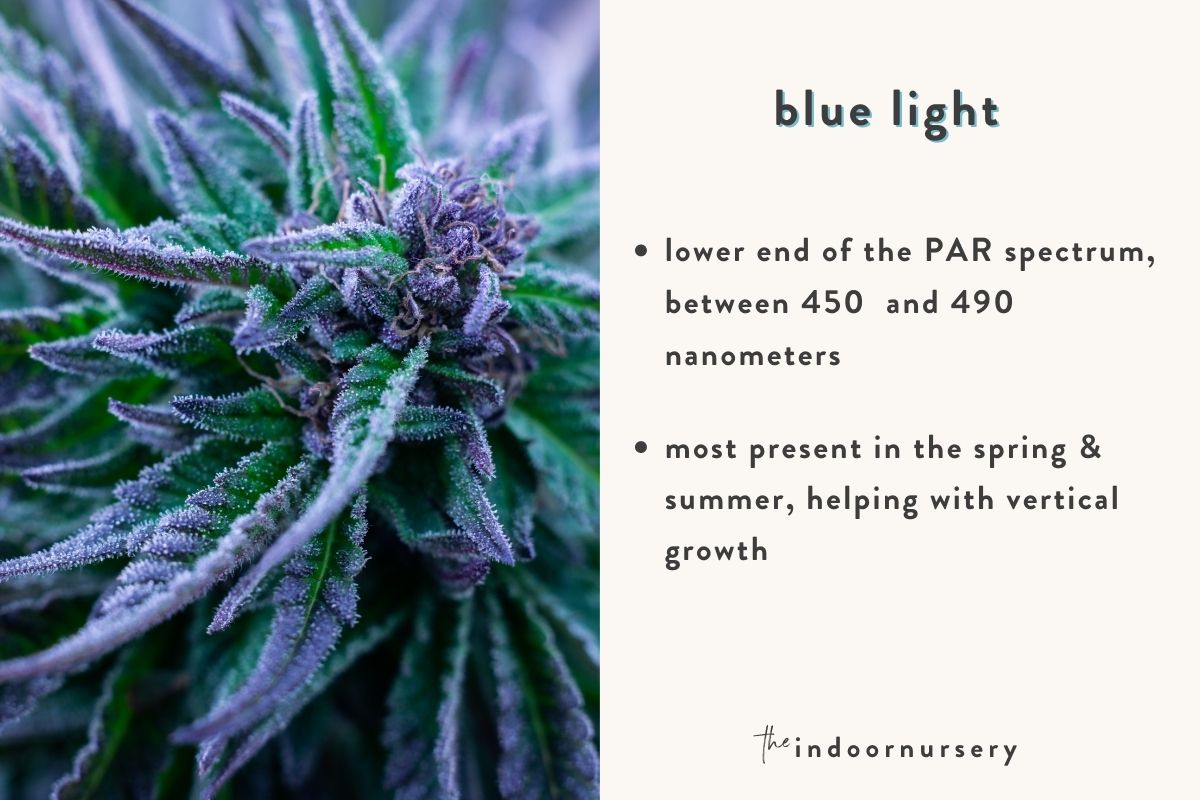
Blue light is on the lower end of the PAR spectrum, between about 450 and 490 nanometers. This wavelength of light, often overlapping with lower UV frequencies, is present in abundance in the spring and early summer. It helps plants moderate their vertical growth. When plants get too little blue light, they grow vertically very quickly, and have long, thin stems and low leaf density. Blue light is absorbed in the top layer of the plant’s tissue, and when there’s enough of it, the plant will be more stout than tall.
green light
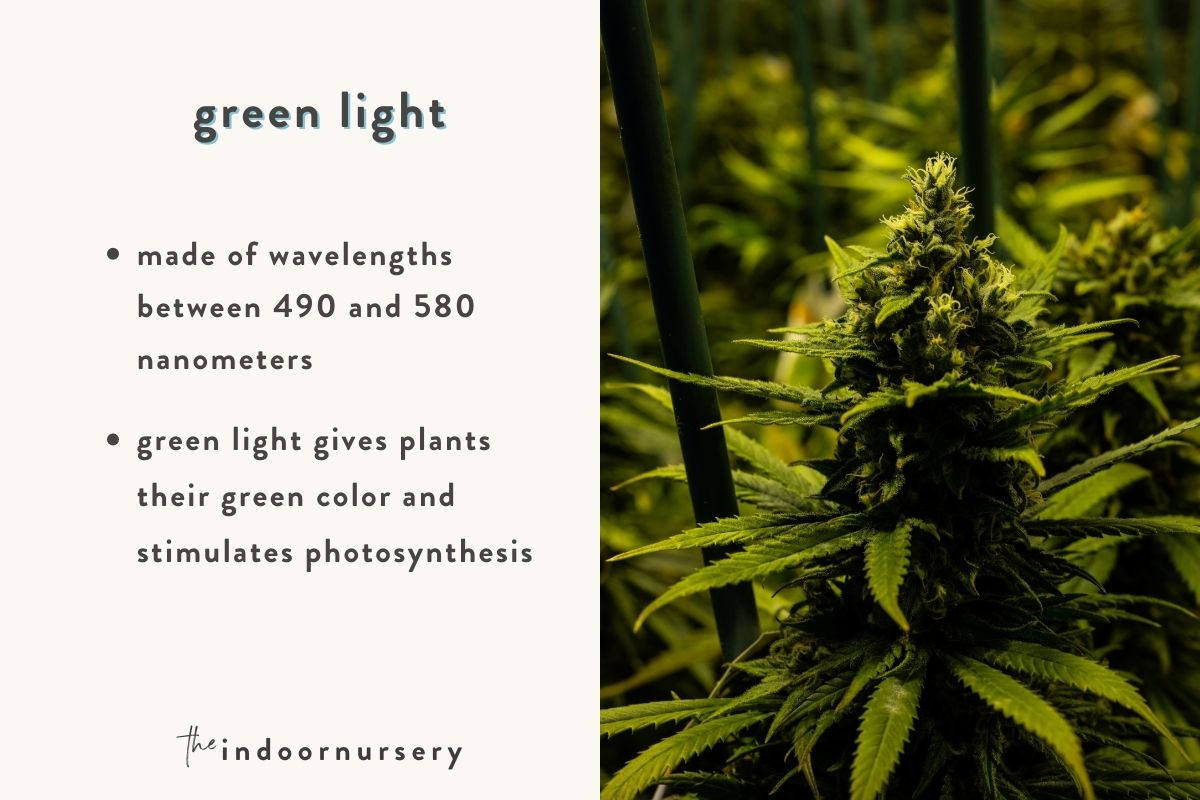
Green light is made of wavelengths between 490 and 580 nanometers. It used to be thought that green light was simply reflected and wasted, but we now know that, although most of green light is indeed reflected or passes through the material, these wavelengths penetrate deep into a plant’s tissue and stimulate some photosynthesis in cells that don’t receive blue or red wavelengths. The reflected green light is what gives plants their color to our eyes.
red light
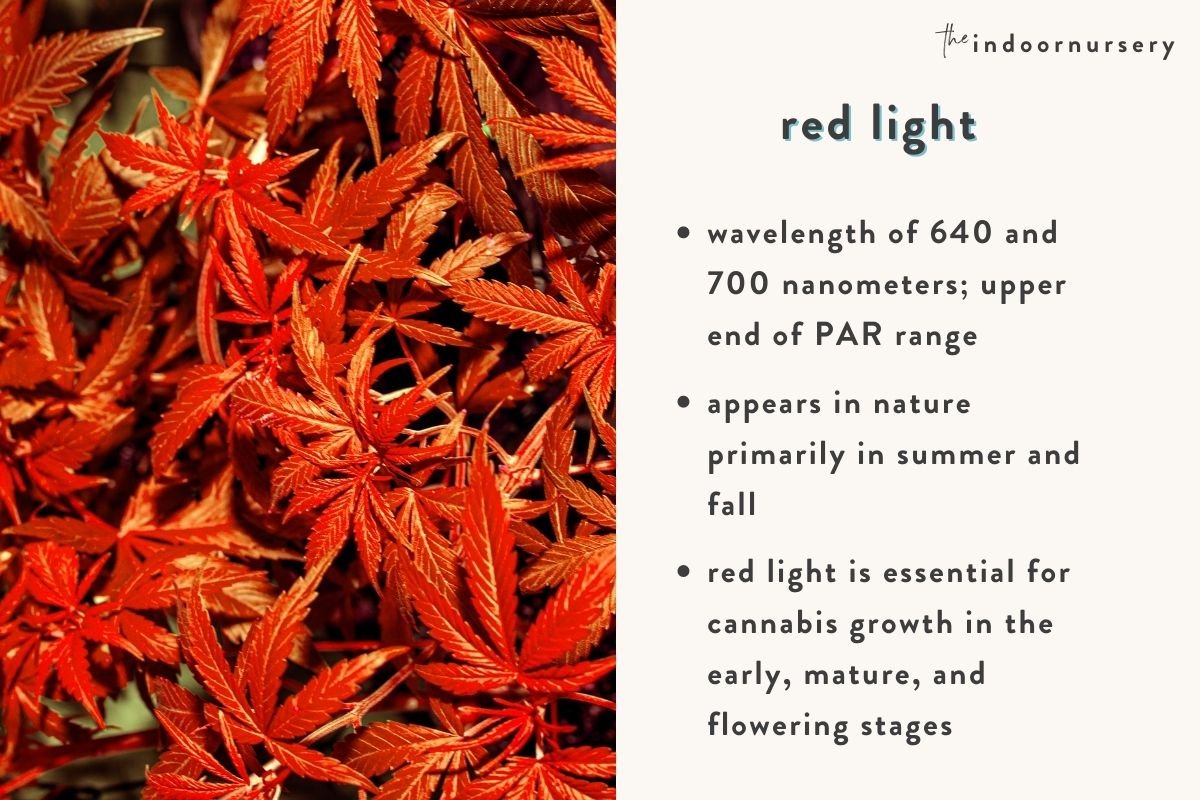
Red light is on the upper end of the PAR spectrum, between 640 and 700 nanometers in wavelength. This is issued more in nature as summer and fall progress, and it triggers flower growth in plants. Red light is easily absorbed by chlorophyll, and it’s absorbed mostly in the upper layers of plant tissue. Red light encourages cell expansion, and without blue light to balance it, vertical growth can stress or damage the plant and diminish its potential harvest. Although it’s countered with enough blue light, red light is essential for cannabis growth in early and mature stages as well as in its flowering stage.
advantages of white light
The main advantage of white light over purple is the fact that it contains the green wavelengths that are mostly reflected, but which contribute to deep-tissue photosynthesis. The white light that results from blue, green, and red wavelengths allows us to see all the colors present and inspect the plant closely and easily in comfortable, natural-looking light.
UV and near-infrared light
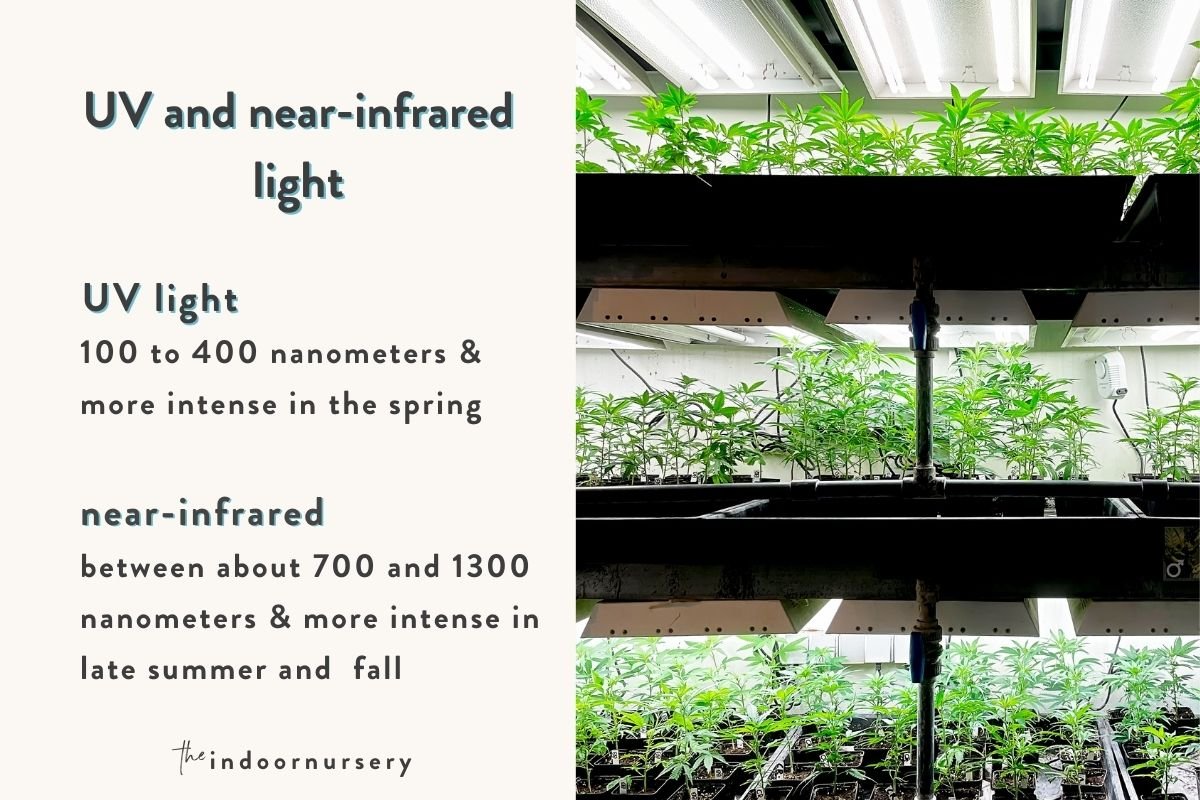
Some full-spectrum lights provide a larger range of light radiation than the visible 400-700 PAR spectrum. UV light varies in intensity from 100 to 400 nanometers, while near-infrared light is beyond red light, between about 700 and 1300 nanometers. UV light is more intense in the spring, and far red light is more intense in the late summer and fall. Some PAR meters extend into this wider range of light detection to measure bulbs that issue light between UV and far red.
what color light is best for plant growth?
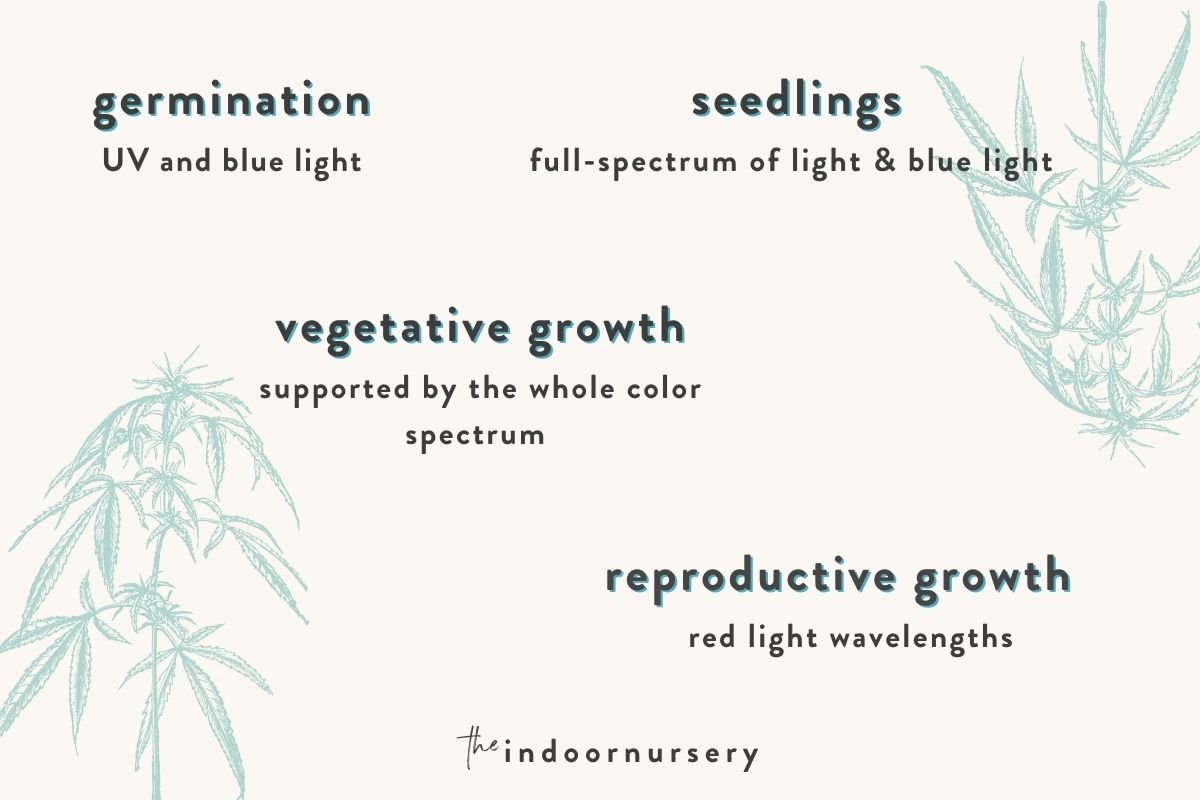
A cannabis plant can use photons from any light wavelength to perform photosynthesis, so all colors are useful throughout growth, but each color has its particular importance in one stage or another. This has to do with the sun: throughout the year, Earth receives different amounts of light wavelengths when the sun is closer and days are longer, than those when the sun is further and days are shorter. When plants are young in spring, they are growing in lots of blue and UV light, but as the year goes on and the daylight hours become shorter, more red light is reaching the plants, and they start producing flowers. Similarly, the distance between the plant and the grow light affects its growth at various stages of life.
While blue light is more necessary in the early stages of growth, it’s also important in low quantities in mature stages. On the other hand, some red light is necessary to support young plant growth, but without blue light, plants may grow too quickly. Green light is important at all stages of growth, especially for indoor growers. The three colors together produce the white light that allows us to inspect a cannabis plant throughout its lifetime. It’s easier to see in white light than in purple light, and it allows us to monitor our plants for discoloration, pests, or diseases. When these issues are diagnosed early, they are easier to control.
what color light is best for germination?
UV and blue light are best for seed germination. At this stage of the cannabis plant’s growth, it can’t perform photosynthesis and its growth is driven by heat and moisture. UV and low-wave blue light is able to penetrate the cannabis seed’s shell and encourage germination.
what color light is best for seedlings?
Seedlings have a stem and a few leaves and will need the full spectrum of light to perform best. Blue light, however, is critical during this stage to regular the plant’s growth. When seedlings stretch or reach, there is too much space between leaf nodes. A young plant with enough blue light (10% to 30%), will make leaves and grow at a pace, without overextending itself.
what is the best color spectrum for vegetative growth?
Vegetative growth is supported, again, by the whole color spectrum. Red light is most easily absorbed by chlorophyll, and this easy-access energy helps a plant grow quickly. However, blue light is essential at this stage to regulate that growth. Again, too much red light can result in excessive and detrimental growth. A stout, bushy plant will produce more marijuana flower than a tall, thin one. During this phase, lots of leafy growth is important for nodes, or bud sites, to develop, where the plant’s flower will sprout.
what is the best color spectrum for reproductive growth?
Mature plants are putting a lot of energy toward producing flowers which, in nature, would be full of seeds. Red wavelengths are more easily absorbed by plants, and this increased energy supply is used to create reproductive materials (flower buds and seeds). For annual cannabis plants, who die each year at the end of their growth cycle, the reproduction cycle that’s supported by red light is essential to produce and drop seeds for next year’s growth. While we want to decrease the amount of seeds, healthy flower will produce the marijuana plant’s signature resin that the buds are harvested for.
how does the color of light affect photosynthesis?
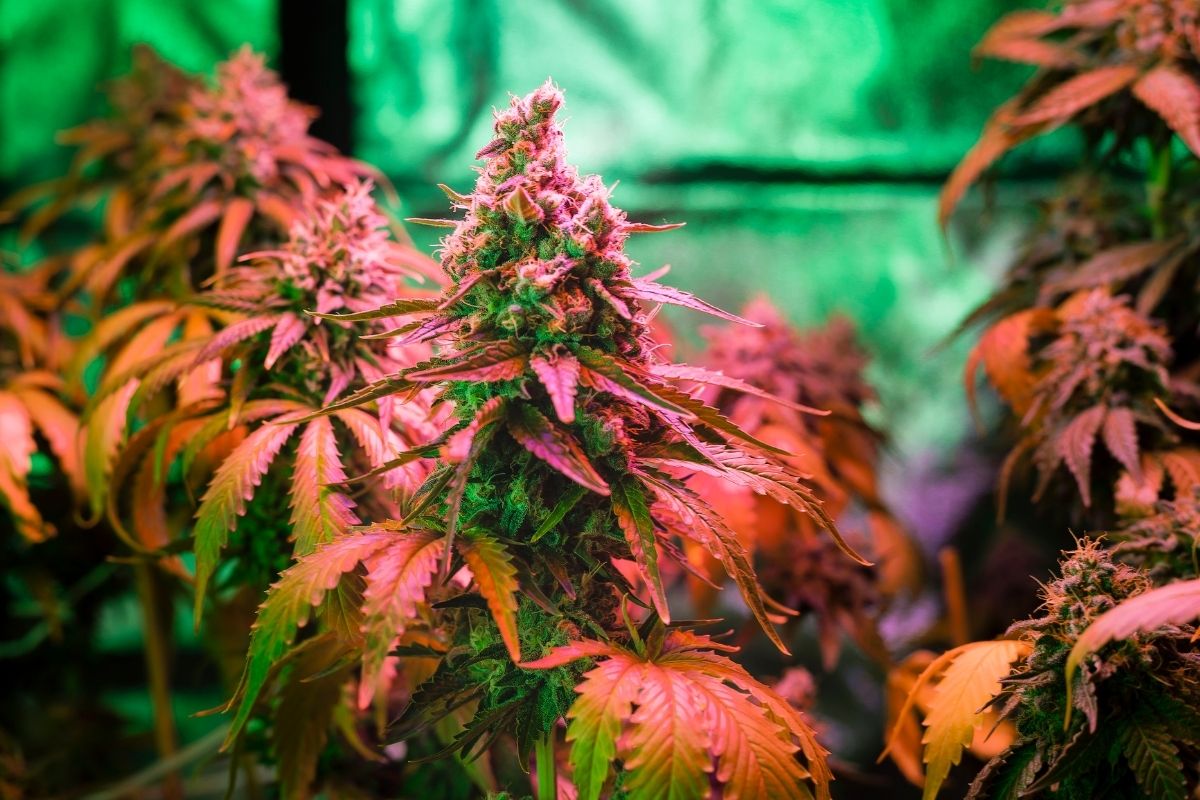
Light radiation is measured as a frequency, and lower frequency light has less energy than higher frequency does. This means that the color of light has an effect on photosynthesis because lower frequency light (UV and blue) has photons with less energy than higher frequency light (red and far red). More energy-dense photons can support more photosynthesis in a plant. The intensity, or number of photons being issued, isn’t affected by the color of the light.
When all things are kept equal, the rate of photosynthesis changes with light, increasing as more red light is available. The energy-dense red light is especially useful when plants are creating flower and seeds, a process which requires a lot of fuel to power. Blue light is more useful when a cannabis plant is younger and producing stems and leaves, and green light is useful in both stages since it promotes photosynthesis more deeply in plant tissue than either red or blue light does.
how does temperature affect plant growth?
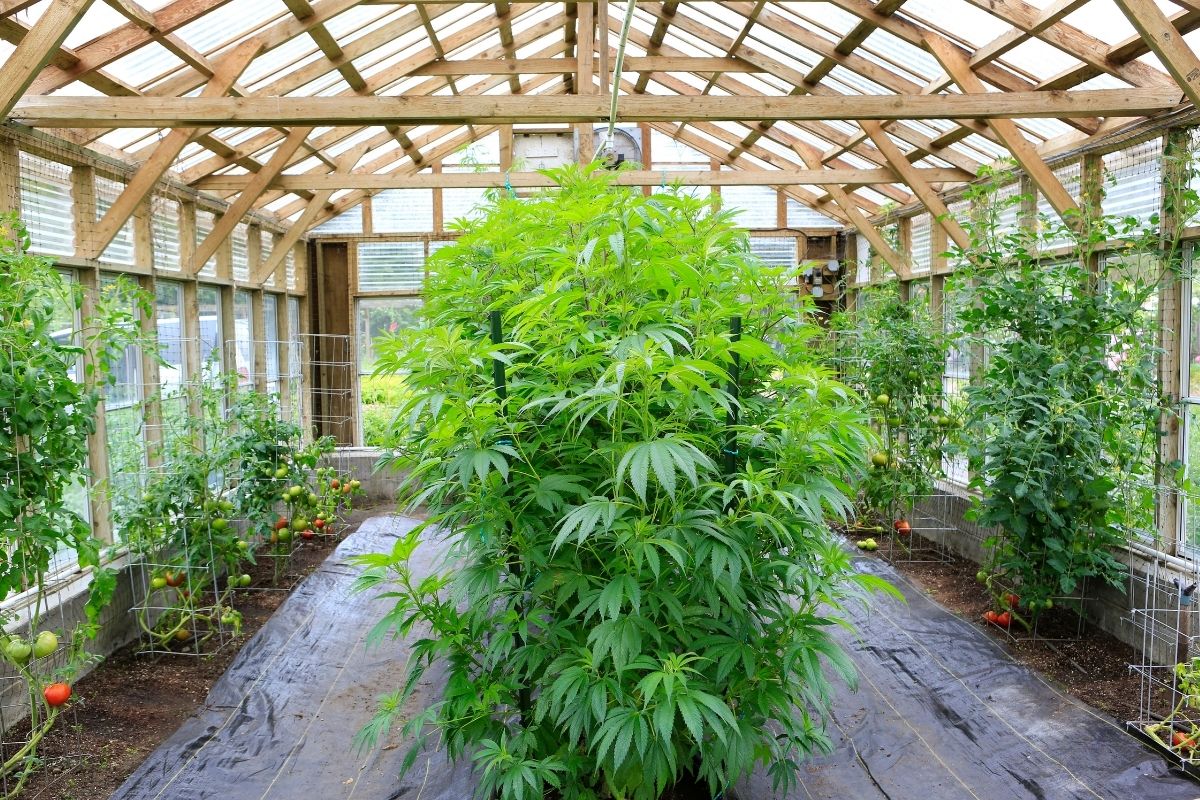
Moderate temperatures are essential for cannabis plant growth, so if your light is creating too much heat, it’s important to manage the growing environment. Adding a fan, dimming the lights, or dehumidifying the space can all contribute to lowering the temperature. Even the best grow lights come with built-in fans that help regulate the temperature, but by default, light bulbs will generate some heat that will need to be monitored.
what colors of light can make plants grow faster?
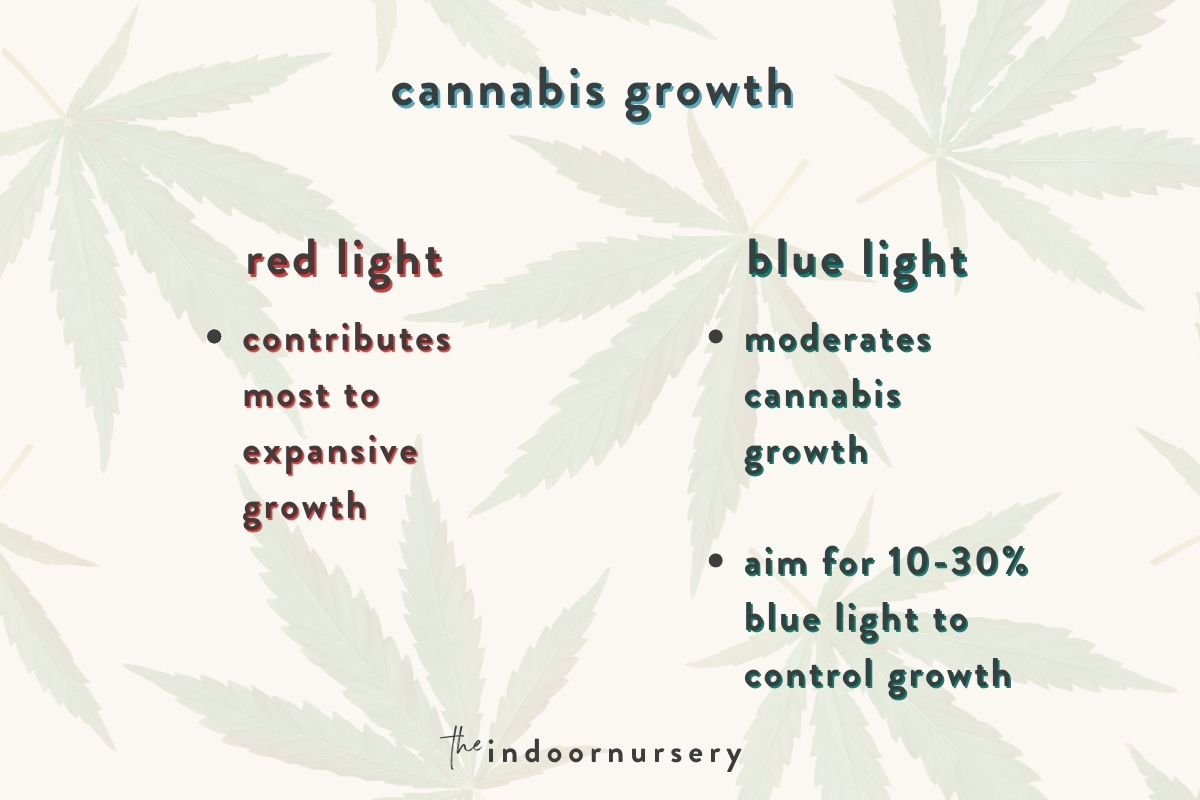
Depending on the stage of growth, all colors contribute: red most contributes to expansive growth, while blue moderates it. Without enough blue light, the red spectrum won’t be balanced and vertical growth can get out of hand and be detrimental to the health of the plant. The best shape for a cannabis plant is short and bushy for the most marijuana flower production, so providing between 10% and 30% blue light will keep your plant growth under control.
how many hours of light do indoor plants need?
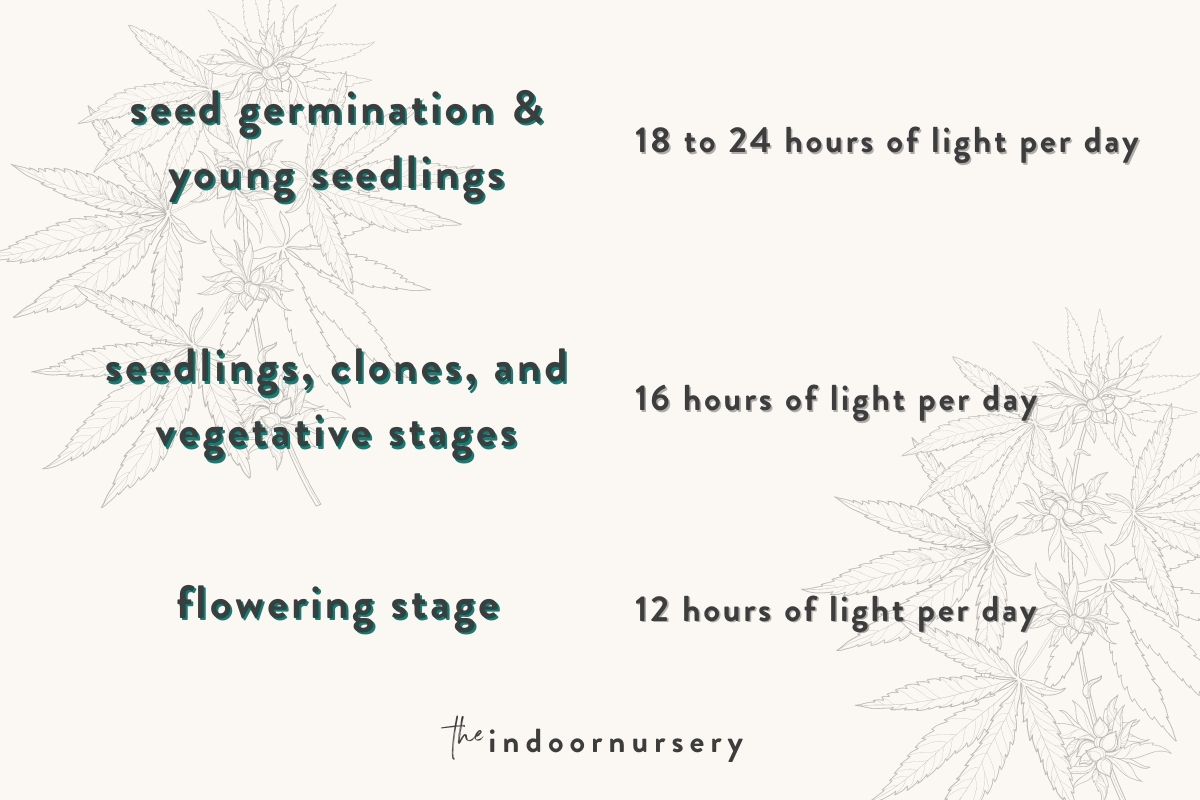
Cannabis plants need different hours of light at different stages of growth. Like the color of light, the time of the year conditions the plant to receive lots of light in spring, when it’s germinating and growing as a seedling into a bush, and fewer hours of light as the year progresses. The different stages include:
- Seed germination and young seedlings – 18 to 24 hours of light per day
- Seedlings, clones, and vegetative stages – 16 hours of light per day
- Flowering stage – 12 hours of light per day
final thoughts
Purple lights will get the job done, but using white lights to grow your cannabis plants indoors makes it easier for you, the indoor gardener, to care for the plant while helping the plant grow as strong and healthy as it can to maximize its yield.
More about lighting
- How To Use Grow Lights For Indoor Plants
- 5 Best Grow Light Strips For Indoor Plants
- Our *hands on* MARS HYDRO TSW 2000 review (with photos)
- Understanding weed light cycles: Get the most from your harvest
- Indoor plant lighting guide: where to put your plants
- How close should grow lights be to plants?
- Best grow lights for seedlings: how to sprout your seedlings safely
- Guide: full-spectrum light for plants (+grow light spectrum chart)
- 10 best LED grow lights for indoor plants

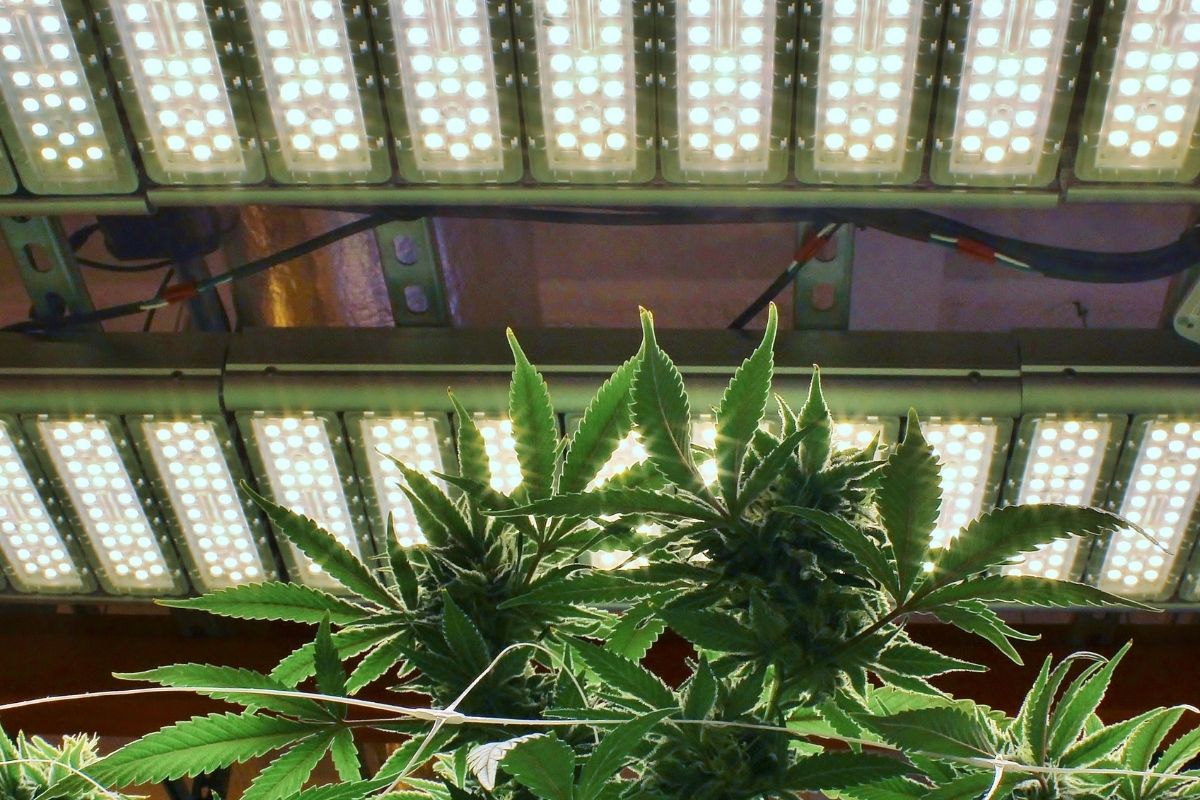
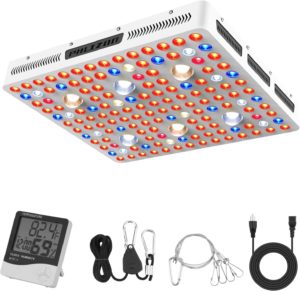
Are UFOs white light full spectrum any good for indoor cannabis grow ?
Especially the 200w ones
What should i look for ?
They seem pretty cheap & maybe they might do the job better ?
Hey Johnny,
I just took a look at the UFO’s full spectrum 200W specs: 430~440nm, 450~475nm, 620~630nm, 650~670nm, and White, IR (730nm). Keeping in mind I haven’t used these grow lights myself. With this spectral range, I can’t see a problem recommending the UFOs for a cannabis grow.
They also have a respectable cover, 7.2×7.2ft, so that’s nice to see.
If you end up using them, be sure to pop back in and tell me how they went.